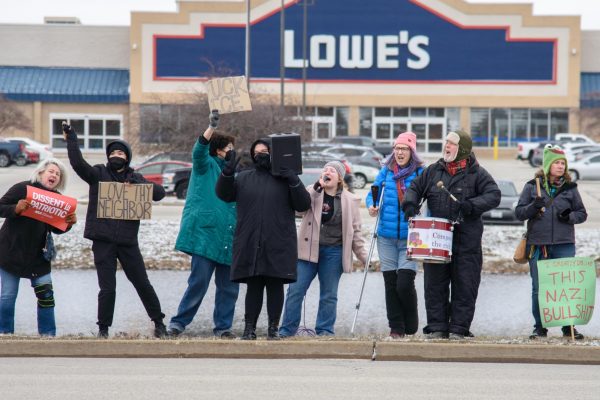Jewish student reflects on religious celebrations, misconceptions
Natalie Weissburg, freshman in ACES, talks about the importance of her Jewish upbringing when it comes the variety of celebrations such as Purim, Rosh Hashanah and more.
Mar 10, 2022
As spring break approaches, an important date for those of the Jewish faith is March 16.
On this day, people will gather together to celebrate Purim. Purim commemorates the saving of the Jews from Haman — Haman was a biblical empire official in the Book of Esther who unsuccessfully tried to kill all Jews in the Persian empire.
Natalie Weissburg, a Jewish-American freshman in ACES, is one of the many Jews throughout the world who will partake in the commemoration. As she was raised in the Jewish faith, Weissburg found herself in the center of many Jewish celebrations.
“I was definitely raised conservative Jewish,” Weissburg said. “I don’t have any limitations to the way that I dress or anything but my family celebrates all the holidays that are pretty traditional. We have a lot of church traditions.”
Weissburg said that her family would celebrate holidays at their synagogue, a Jewish place of religious worship, and at home.
Get The Daily Illini in your inbox!
“We don’t have any family outside of immediate family that lives by us,” Weissburg said. “So I guess we would just always celebrate at the synagogue because it was like a big group.”
Weissburg said as a child, Purim was her favorite holiday due to the fun, kid-oriented atmosphere.
“We eat Hamantaschen, which are triangular cookies, and they’re supposed to be like Haman’s triangular hat,” Weissburg said.
Weissburg also described another celebratory aspect of Purim, one that involves the service.
“During the service, it’s like a very fun Torah portion and everybody gets groggers which are little swirly noisemakers,” Weissburg said. “When you’re older, you can dress up in a sort of a lazy costume and drink at parties, so it’s just a good time.”
Weissburg also explained that during Purim, a lot of dads dress as Haman.
“Pretty much every single dad at a Purim party will be dressed as Haman,” Weissburg said.
Weissburg and her family also celebrates Rosh Hashanah, the Jewish new year, and Yom Kippur, a significant holiday for Jews that centers around repentance, at their synagogue.
“I would go to the service part at my synagogue and then I’d go to Hebrew school after,” Weissberg said about Rosh Hashanah. “There’d be apples and honey.”
Weissburg also said that apples and honey are eaten during Rosh Hashanah. This is to make sure that the year ahead would be sweet.
Weissburg said that along with the community being a vital part of Judaism, it is also her favorite. She explained that a common faith brings the few Jews in the world together.
“Every time I’m at a party, I always find a Jewish person right away and I’m like, I don’t know anybody at this party so, like you have to be my best friend by law,” Weissburg said. “We’re Jewish and there’s not a lot of Jewish people.”
Weissberg said that the small population of Jews in the world is important to her. She explains that during the Holocaust, the misconception that Jews were a large and dominant community fed into antisemitic ideology.
“There’s really not many of us on this planet,” Weissberg said. “I think about how a major fear technique in Germany at the time was making it seem like there was a huge Jewish population when really the Jewish population in Germany was the same as it is in the world currently, about like point one percent.”
Weissberg also wants society to know that Judaism is not a race, but rather an ethnic religion.
“There are people who aren’t ethnically Jewish who are religiously Jewish and people who aren’t religiously Jewish who are ethnically Jewish,” Weissberg said.
Like many other aspects of her upbringing, Weissburg’s Bat Mitzvah, a coming of age ceremony that welcomes an individual as a full member of the Jewish community, was traditional.
“I read all the prayers that are usually read and I had like a big poofy dress,” Weissburg said. “All my grandparents were there and it was in my synagogue and I had like my little after party with my school friends.”
Weissburg also said she wore a tallit, which is a religious shawl that Jews wear following their Bat or Bar Mitzvah. The shawl is worn during prayer or at religious services and is traditionally white with blue stripes at the end. Weissburg’s tallit had a slight variation.
“Mine was white with pink stripes because I was 11,” Weissburg said.
Before her Bat Mitzvah, Weissburg also chose her Hebrew name — the religious name a Jew goes by during religious services.
“I was in my Cantor’s office and we were working on one of my prayers for my Bat Mitzvah and then at the end when I was leaving, he was like, ‘oh do you want to pick your Hebrew name now?’ I asked if any of them (the names) started with an N, and he said Nechama,” Weissburg said.
Weissburg explained that ‘Nechama’ means ‘comfort’ in English.
Regarding publicizing her religious practice, Weissburg said she was not afraid to read from the Torah, the holy text of Judaism usually written in Hebrew, in front of her friends and family.
“I was the only Jewish person at my normal school so all of my school friends were there and I was like, man, they’re probably losing their marbles right now,” Weissburg said. “None of them had ever heard me speak Hebrew before.”
Although Weissburg said she is not fluent in Hebrew, she learned a Jewish proverb about being open-minded towards others that she holds close to her heart.
“Each person is their own world, every person has their own life and their own way of experiencing the world that’s sort of precious and unique,” Weissberg said. “So whenever I meet someone, I like to think, well this person is a world, they are all their experiences, and they’re bringing that with them into this interaction with me.”






